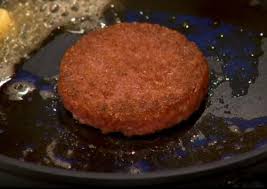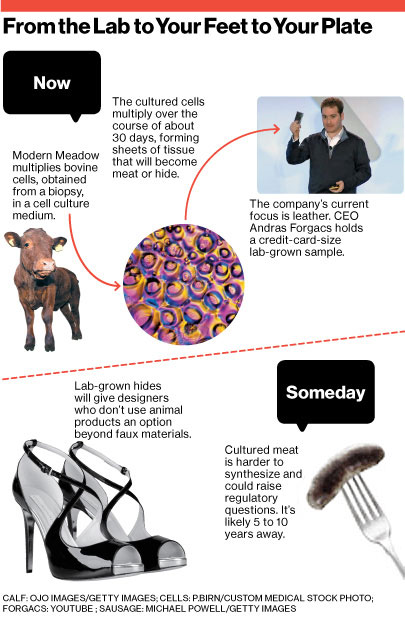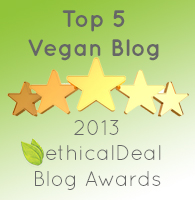If your first reaction is, “gross, absolutely not,” then you wouldn’t be alone, but would you reconsider if you knew that lab-grown meat would be free of hormones, pesticides, antibiotics, disease and would eliminate the ethical issue of animal cruelty and could effectively change the widespread harm to our environment imposed by factory farming in this country? Do I hear anyone thinking, “hmm, then again, let me think about that”?
Please Vote in the Comments Section:
Would I eat lab-grown meat?
__ 1) Not a chance
__ 2) Sure, why not?
__ 3) Wait & see
__ 4) Try to convince me
These are not rhetorical questions requiring a wild and vivid science-fictional journey to a futuristic land. We won’t all be wearing silver unitards and living in apartment pods when the choice between real and “cultured” meat and leather is available to us. Cloning meat and leather is successfully being done right now and may be available commercially as soon as 5 to 10 years!
Because the idea of “cultured” meat and leather is bound to be a very controversial subject and an emotional issue, let’s explore just some of the by-products of factory farming for meat and leather that could be mitigated by lab-grown meat and leather:
• 51 percent or more of global greenhouse-gas emissions are caused by animal agriculture, according to a report published by the Worldwatch Institute. The extreme amount of waste from factory farms pollutes our land, air and water.
•Animal agriculture is responsible for more deadly greenhouse gases than all the cars, trucks, planes, ships, and other forms of transportation in the world combined. These greenhouse gases accelerate global warming which, scientists say, will increasingly lead to catastrophic climate-related disasters around the world.
•In this country, roughly 29 million pounds of antibiotics — about 80 percent of the nation’s antibiotics use in total — are added to animal feed every year, mainly to speed livestock growth. This widespread use of antibiotics on animals contributes to the rise of resistant bacteria, making it harder to treat human illnesses, according to the National Resources Defense Council
•About 70% of U.S. beef cattle come from farms with at least 5,000 head of cattle.
•Ten large companies produce more than 90 percent of the nation’s poultry.
•Nearly 80 percent of the agricultural land in the U.S. is used to feed the nearly 10 billion farm animals who are slaughtered each year in this country alone. In fact, more than 40 percent of the total land mass of the U. S. is used to raise animals for food.
•Animals raised for food generate more than 100 times more excrement than the entire U.S. human population, but this raw waste is not treated in sewage systems. This excrement often contains toxins and other pollutants which find their way into groundwater.
•Waste generated by factory farms has already polluted more than 35,000 miles of rivers in 22 states, and contaminated groundwater in 17 states.
•With rising demand for meat from rapidly developing nations in, for example China and India, the market for meat is expected to double by mid-century.
•Every year, the global leather industry slaughters more than a billion animals and tans their skins and hides. Many of these animals suffer all the horrors of factory farming—including extreme crowding and confinement, deprivation, and unanesthetized castration, branding, tail-docking, and dehorning—as well as cruel treatment during transport and slaughter.
If producing meat and leather in a lab would help reduce factory farming and its destruction of the environment, would you be willing to get on board? Recently, a cultured hamburger, several years in the making by Dr. Mark Post, a Dutch researcher at the University of Maastricht in the Netherlands, was cooked, eaten and critiqued in London. At a cost of $325,000, this burger was said to be “dry and a bit lacking in flavor,” ” feels like a conventional hamburger but tasted like an animal-protein cake,” despite which it’s “a very good start.”
The burger consists of tens of thousands of strands of protein grown in petri dishes from cattle stem cells. Stem cells are the basic cells that can turn into tissue-specific cells. These particular cells were derived from cow shoulder muscle and were multiplied to form tiny strips of muscle fiber, of which 20,000 were used to create the burger. Added to the burger were also breadcrumbs, salt and natural beet juice for coloring. Cooked in butter, served on a bun and topped with lettuce and tomato slices, the burger looked like a “real hamburger” but was described as lacking in fat. “We’re working on that,” stated Dr. Post.
Leather production, a lucrative $63 billion per year industry, intertwined with the factory farm industry, is also gearing up for lab-produced products to rival naturally derived hides. As recently reported, a company called Modern Meadow has created leather from tissue cultures and test tubes. The company’s CEO, Andras Forgacs, presented a credit card sized sample of leather, with the same softness and smell of real leather, at the recent TED Global conference in Scotland. Modern Meadow has deemed the growing of leather less daunting and more lucrative than the growing of meat, as flavor, texture and aroma are not as critical. Soon the company will be rolling out lab-grown sheets of at least 10 inch squares and will start to collaborate with designers on accessories and apparel.
From the viewpoint of those concerned the ethical treatment of animals, these developments would seem to be a wonderful positive direction. Designers who refuse to use leather in their collections, including Stella McCartney and Vivienne Westwood among many others, would have a leather alternative. Ingrid Newkirk, president of People for the Ethical Treatment of Animals says, pragmatically that “she’s been following tissue engineering for two decades…the impact of cultured leather will be phenomenal and wonderful.” Presently, the use of pleather is growing rapidly in the fashion industry and provides a viable alternative to leather. For more about pleather, click here to read my blog called “2013 is the Year of Pleather.”
Since it’s safe to say that there’s generally a visceral “yeech” reaction initially elicited by the idea of scientifically grown meat and leather, open minded people may soon embrace the fact that a clean, sterile laboratory might be preferable to contaminated, filthy factory farms that pollute the environment. If anything, this “weird” science may eventually be a key to saving the planet and providing food for an ever-growing population.
It will be fascinating to track how vegans and vegetarians view the possibility of lab-grown meat and leather goods, as this eventuality comes to pass. To dedicated vegans, plant-based nutrition will always be considered nutritionally and ethically superior to meat of any kind. When Dr. Post was asked if cultured meat would be appealing to vegetarians, he was quoted as saying, “Vegetarians should remain vegetarians. That’s even better for the environment.”
 In the meantime, PETA is offering a $1 million prize to the first contest participant able to make in vitro commercially viable chicken meat by March 4, 2014. The contestant must do both of the following:
In the meantime, PETA is offering a $1 million prize to the first contest participant able to make in vitro commercially viable chicken meat by March 4, 2014. The contestant must do both of the following:
- Produce an in vitro chicken-meat product that has a taste and texture indistinguishable from real chicken flesh to non-meat-eaters and meat-eaters alike.
- Manufacture the approved product in large enough quantities to be sold commercially and successfully sell it at a competitive price in at least 10 states.
The judging of the taste and texture will be performed by a panel of PETA-approved judges, who will sample the in vitro chicken prepared using PETA’s own fried-chicken recipe. The in vitro chicken must attain a score of at least 80 out of 100 when evaluated in order to win the prize.
Eaters of all kinds will be watching this story as it develops! Which side of this issue are you on and what are thoughts?
Read more about factory farms and their harm to the environment, Dr. Mark Post, Modern Meadow…check out these links:
NRDC http://www.nrdc.org/water/pollution/ffarms.asp
Farm Sanctuary http://www.farmsanctuary.org/wp-content/uploads/2013/01/Environment-Brochure-FINAL-3-24-09.pdf
New York Times http://opinionator.blogs.nytimes.com/2013/07/09/breeding-bacteria-on-factory-farms/?ref=factoryfarming
http://www.nytimes.com/2013/05/14/science/engineering-the-325000-in-vitro-burger.html?pagewanted=all&_r=0
PETA http://www.peta.org/issues/animals-used-for-clothing/leather-animals-abused-and-killed-for-their-skins.aspx
Modern Meadow http://modernmeadow.com
WorldWatch Institute http://www.worldwatch.org
xox Ellen













Not a chance
3 – Wait & see
Yes, wait & see is a practical option.
I hate the smell of meat, leave alone eat it. Glad to see they could end animal cruelty, but other than that, would not eat it. Would wear leather that was cruelty free.
I am for anything that puts an end to animal abuse!
Me too!
“Wait and see” on the meat, YES on the leather!
Interesting response!
Excellent write-up. I certainly appreciate this site.
Continue the good work!